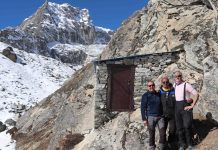by InTrieste
Perched at roughly 5,050 meters above sea level, near the base camp of the world’s highest peak, a remote seismic station on Mount Everest has received significant upgrades aimed at deepening scientific understanding of glacial activity and climate-driven geological processes.
The Everest seismic station, operated by Italy’s National Institute of Oceanography and Applied Geophysics (OGS) in collaboration with the EvK2CNR association and Nepal’s National Academy of Science and Technology (NAST), has been equipped with a new suite of instruments designed to better detect seismic events linked to ice movement and rock instability. The facility sits near the EvK2CNR Pyramid Laboratory and Observatory, a longstanding research structure just below the Khumbu Glacier.
A team of OGS researchers, Denis Sandron and Marco Romanelli, recently traveled to the site to carry out maintenance and install new equipment — a demanding mission in thin air and harsh weather conditions. According to the institute, the effort reflects a broader push in the scientific community to expand monitoring capabilities in high-altitude and climate-sensitive environments.
Among the upgrades is an accelerometer paired with the station’s existing broadband seismometer, allowing for more precise measurements of both local and global seismic events. A new infrasound sensor has also been added to capture low-frequency atmospheric vibrations associated with rockfalls, ice collapses and glacier movements.
“These instruments will allow us to deepen our investigations into so-called ‘icequakes,’ seismic signals generated by glacier dynamics,” said Franco Pettenati, a geophysicist at OGS and scientific coordinator for the Everest station. “These studies provide valuable insight into climate change processes, particularly in regions where glacial mass and stability are rapidly evolving.”
The project also includes enhancements to the station’s GPS monitoring system. Researchers replaced the main GPS receiver with a commercially available unit and installed an additional low-cost receiver developed by OGS engineer David Zuliani. The system, operated jointly with the University of Trieste, will support research into the region’s geodynamics and crustal deformation.
Connectivity has been modernized as well, with a new Wi-Fi bridge linking the seismic and GPS stations to the Pyramid Laboratory server — replacing an older underground cable system. The improvement is expected to facilitate more reliable and efficient data transmission from one of the most logistically challenging research sites in the world.
Since its inauguration in 2014, the Everest seismic station has continuously recorded ground motion at multiple frequencies, sending data via satellite to Kathmandu and then to OGS headquarters in Italy. Its strategic location has made it a key monitoring point for Himalayan seismicity. On Jan. 7 of this year, the station captured strong motion from a magnitude-7.1 earthquake in central Tibet, located roughly 70 kilometers from the epicenter — making it the closest broadband station to the event.
Researchers say that continued monitoring is crucial, not only for understanding regional tectonics but also for tracking environmental shifts in one of the fastest-warming mountain ranges on the planet. Glacial retreat and ice-mass loss, driven by rising global temperatures, have increased scientific interest in high-altitude seismic signals that can reveal early signs of structural instability.
“Mount Everest and the Himalayas serve as a natural observatory for climate and geological processes,” Dr. Pettenati noted. “Having robust and reliable instruments here is essential to interpreting how these changes are unfolding — and what they mean for both local environments and the wider world.”
































